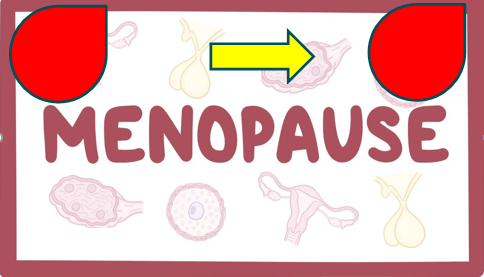BASIC TERMINOLOGIES–
- Menopause– The term ‘menopause’ means cessation of menstruation. It can be defined as physiologic or iatrogenic cessation of menses (amenorrhea) due to decreased ovarian function.(Age of menopause is normally between 47-50 years; occasionally between 40-46,and in other extreme as late as 55 years of age )
- Perimenopause– It refers to the several years (duration varies greatly) before and the 1 year after the last menses.(most symptomatic phase because hormones are fluctuating)
- Menopausal transition– It refers to the years in perimenopause that lead up to the last menses; it is characterized by changes in the menstrual pattern .The menopausal transition lasts 4 to 8 years. (longer in women who smoke and in women who were younger at onset of menopausal transition)
- Postmenopause – It refers to the time after the last menstrual period.
- Climacteric- It indicates cessation of the reproductive period of life
PHYSIOLOGY OF MENOPAUSE-
As ovaries age, their response to the pituitary gonadotropins follicle-stimulating hormone (FSH) and luteinizing hormone (LH) decreases, initially causing the following:-
1)A shorter follicular phase (with shorter and less regular menstrual cycles)
2)Fewer ovulations
3)Decreased progesterone production.
4)During menopausal transition, double ovulation and luteal out-of-phase (LOOP) events (ie, premature formation of a follicle due to the major surge in FSH during the luteal phase) occur and occasionally cause estradiol levels to be above normal. The number of viable follicles decreases; eventually, the remaining follicles do not respond, and the ovaries produce very little estradiol.
5)Estrogens are also produced by peripheral tissues (eg, fat, skin) from androgens (eg, androstenedione, testosterone). However, the total estrogen level gradually decreases during the 5 years after menopause, and estrone replaces estradiol as the most common estrogen.
6)Androstenedione levels decrease by half.
7)The decrease in testosterone, which begins in young adulthood, does not accelerate during menopause because the stroma of the postmenopausal ovary and adrenal gland continue to secrete substantial amounts.
8)Decreased levels of ovarian inhibin and estrogen, which inhibit pituitary release of LH and FSH, result in a substantial increase in circulating LH and FSH levels.
9)Superficial cells in the vagina are lost, leading to a more alkaline ph. As a result, the number of lactobacilli decreases and pathogenic bacteria overgrow, increasing the risk of infection.
10)Premature ovarian failure (primary ovarian insufficiency) is cessation of menses due to non iatrogenic ovarian failure before age 40. Contributory factors are thought to be primarily genetic or autoimmune.
Symptoms and Signs of Menopause-
Changes in the menstrual cycle usually begin during a woman’s 40s, with variation in cycle length. Symptoms can last from 6 months to > 10 years and range from nonexistent to severe.
A persistent difference in consecutive menstrual cycle length of ≥ 7 days defines early menopausal transition. Skipping ≥ 2 cycles defines late menopausal transition. The marked fluctuations in estrogen levels may contribute to other perimenopausal symptoms and signs such as-
1)Breast tenderness
2)Changes in menstrual flow
3)Moodiness
4)Exacerbation of menstrual migraines.
5)Vasomotor symptoms– Hot flushes (hot flashes) and/or night sweats due to vasomotor instability affect 75 to 85% of women and usually begin before menses stop.
Women feel warm or hot and may perspire(night too).
6)Vaginal symptoms–
It include dryness, dyspareunia, and occasionally irritation and itching. Vulvar and vaginal mucosae become thinner, drier, more friable, and less elastic, and vaginal rugae are lost.
7)Genitourinary symptoms– Vulvovaginal atrophy
Urinary urgency, dysuria, frequent UTI/vaginitis.
8)Neuropsychiatric symptoms -Poor concentration, memory loss, depression tendencies, anxiety, etc. may transiently accompany menopause, recurrent night sweats can contribute to insomnia, fatigue, irritability, and poor concentration by disrupting sleep.
9)Cardiovascular symptoms-After menopause, levels of low-density lipoprotein (LDL) cholesterol increase in women (explains why artherosclerosis and coronary artery diseases are common after menopause, before that, the high estrogen levels may protect against coronary artery disease.,). Levels of high-density lipoprotein (HDL) cholesterol remain about the same as before menopause.
10)Musculoskeletal symptoms -Up to 20% of bone density loss occurs during the first 5 years after menopause. After this period of rapid bone loss, the age-related rate of bone loss in women is similar to that in men.
DIAGNOSIS OF MENOPAUSE-
Diagnosis of menopause is clinical. Perimenopause is likely if the woman is in the appropriate age range and has some of the symptoms and signs of perimenopause. However, pregnancy should be considered. Menopause is confirmed when a woman has had no menses for 12 months and there is no other obvious cause. Secondly, pelvic examination is done; the presence of vulvovaginal atrophy supports the diagnosis. Any abnormal findings (eg, pelvic masses) are evaluated. Also, FSH levels may be measured, but this test is rarely necessary except perhaps in women who have had a hysterectomy and in women who are younger than the usual age of menopause. (Consistently elevated levels confirm menopause).
The following postmenopausal women should be screened for osteoporosis-Those who have a high risk of fracture (eg- patients with a family history of osteoporosis). Those who have a history of eating disorders, a low body mass index (BMI), chronic corticosteroid use, gastric bypass surgery, Crohn disease, a malabsorption syndrome, or a prior fragility fracture and all women ≥ 65.
TREATMENT OF MENOPAUSE-
1)Lifestyle modification– For hot flushes, the following may help-
a) Avoiding triggers (eg-spicy food, predictable emotional reactions, etc.)
b) Cooling the environment (eg- lowering the thermostat, using fans,etc.)
c)Wearing comfortable clothing
d)Exercise and weight loss.
e) Over-the-counter vaginal lubricants and moisturizers help relieve vaginal dryness.
f) Consultation to preserve vaginal function.
2)Complementary and alternative medicine-
A wide variety of complementary and alternative therapies have been used to relieve symptoms. It also includes use of regular exercise, paced respirations (a type of slow, deep breathing), mindfulness, or relaxation techniques to reduce hot flushes have had mixed results, although exercise, yoga, and relaxation techniques may improve sleep and reduce stress. Acupuncture has also had mixed results.
Any other medicine either homoeopathy or ayurveda must be taken under physician not over the counter by the menopausal women.
3)Neuroactive drugs-. A low dose (7.5 mg once a day) of paroxetine (an SSRI) is the only approved nonhormone therapy used specifically for hot flushes. However, all of these neuroactive drugs are less effective than hormone therapy.
4)Emerging therapies-
Other therapies that may be useful include the anticholinergic drug oxybutynin, stellate ganglion blockade, and neurokinin B antagonists (5, 6). Kisspeptin and neurokinin B (NKB) antagonists are some nonhormone treatments that appear to reduce vasomotor symptoms and thus reduce the need for estrogen therapies.
5)Hormone Therapy for Menopause(HRT)-Hormone therapy (estrogen, a progestogen, or both) is the most effective treatment for menopausal symptoms. It is used to relieve moderate to severe hot flushes and, when an estrogen is included, to relieve symptoms due to vulvovaginal atrophy.
Hormone therapy improves quality of life for many women by relieving their symptoms but does not improve quality of life for asymptomatic women and is thus not routinely given to postmenopausal women.
If hormone therapy is needed to control menopausal symptoms, clinicians should determine the most appropriate type, dose, route of administration, and duration, based on goals of treatment and individual health risks. Potential benefits and harms due to hormone therapy should be periodically reevaluated.
Criteria for HRT-
A)For healthy women who are < 60 years old or < 10 years past menopause onset– Potential benefits of hormone therapy are most likely to exceed potential harms. If such women are at risk of bone loss or fracture, hormone therapy reduces bone loss and incidence of fractures and can be used in women who are not candidates for first-line drugs for osteoporosis.
2)Women who are > 60 years old or > 10 to 20 years past menopause onset– It is not generally recommended as potential harms of HRT (eg, coronary artery disease, stroke, venous thromboembolism, dementia) are likely to exceed potential benefits.
CONCLUSION-
Menopause is a normal, healthy phase in a woman’s life, but each woman has a unique experience.
Quality of life may decrease if symptoms are severe or if less common symptoms of menopause, such as joint aches and pains, develop. For some women (eg, those with a history of endometriosis, dysmenorrhea, menorrhagia, premenstrual syndrome, or menstrual migraine), quality of life improves after menopause Unless the clinical recommendation is clear then menopausal women requires to be educated about HRT as potential benefits and harms of hormone therapy can be complicated and net benefit and harm can be marginal at the same time health risks may change over time and must be taken under consideration for the treatment in required cases of menopause .
HAPPY HEALING
Contributor- Dr. Apurva Varangi





Greatly explained